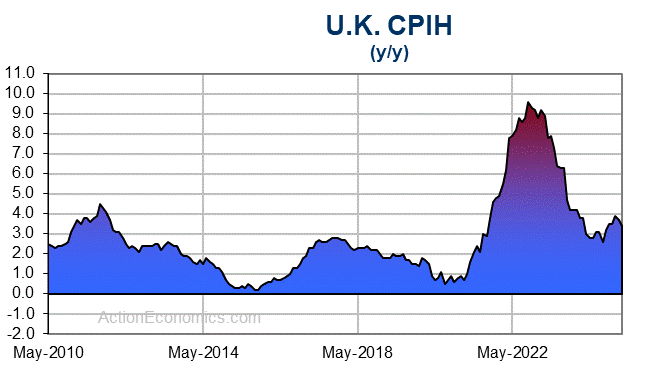Like the ECB, the BoE seems increasingly spooked by the risk of second round effects, against the background of a labor market that is tighter than the central bank factored in. The workforce has failed to expand in line with the easing of virus restrictions, and Brexit is partly to blame. Against this background, companies are forced to offer higher wages to attract and retain staff. Data from the REC (Recruitment and Employment Confederation) said its measures of demand for permanent staff declined for a second month, suggesting that upward pressure has peaked.
UK CPI inflation decelerated more than anticipated. Like the US number yesterday, the headline rate declined to 10.7% from 11.1% in the previous month. CPIH dropped to 9.3% and both readings were lower than consensus expectations predicted. More importantly, core inflation declined – to 6.3% from 6.5%. RPI fell to 14.0% from 14.2% and RPIX dropped to 13.5% from 13.9%. That doesn’t mean inflation is no longer a problem. Indeed, with CPI and RPI still in double digits, the numbers will do little to keep a lid on wage demands and prevent the wave of strikes that will be hitting the country over the holiday period. Still, the lower than anticipated number will take some pressure off the BoE and allow officials to continue to push back against overly pessimistic market expectations on the final rate on Thursday.
BoE warns of rising mortgage costs. The BoE noted that since the re-opening of the economy business have reported increased earnings and falling debt, but warned that “higher costs, lower demand, rising interest rates, and ongoing supply chain disruptions could hit earnings and the ability of some businesses to finance debt.” At the same time the Bank of England highlighted that 4 million households will feel a significant increase in mortgage payments next year, with a further 2 million to be affected by 2025 when their fixed term rate ends. The average payment for those who remortgage is expected to reach GBP 1000 a month next year, GBP 250 more than currently. 670K households are expected to struggle to service their debt. Buy-to-let investors are particularly vulnerable, according to the report, as about 85% of mortgages to landlords were interest only, which makes them highly sensitive to rising interest rates. To compensate landlords would have to lift rental income by around 20%, which “would increase the cost of housing for renters”.

The government budget meanwhile may have been designed to look more prudent than the plans presented by the Truss administration. Yet, most of the austerity measures were pushed back into the future, meaning there is more work for the BoE to do. Another 50 basis point hike is widely expected and fully priced in. Investors will watch individual voting patterns and Bailey’s comments on the rate outlook very closely though. The last time around, Bailey managed to deliver a 75 basis point hike with a dovish spin, by suggesting markets were too pessimistic on the final rate. Judging by market pricing, this remains the case.
Another split vote is in the cards, and some suggest it could be as confusing as a 4-way split. The disagreement among policy makers largely reflects the uncertainty surrounding the economic outlook as well as the outlook for inflation. This also seems to be driving the difference between consensus expectations on the BoE’s final rate in the current cycle and market pricing. The discrepancy is higher for the UK and the BoE than in the US or the Eurozone.
This may be a legacy of the political turmoil earlier in the year, and it may constitute a kind of “uncertainty-premium” that markets are factoring in. Another push back from Bailey and his colleagues against overly pessimistic market views on the terminal rates tomorrow could put fresh pressure on Sterling, especially if the FOMC remains steadfast in its fight against inflation.
Interestingly, the latest Reuters survey still flagged the more optimistic view of many analysts on the interest rate outlook, and it also highlighted that nearly 70% said the main risk was that rates would peak later and at a higher level than they currently expect. They fear that markets may be right after all.
Click here to access our Economic Calendar
Andria Pichidi
Market Analyst
Disclaimer: This material is provided as a general marketing communication for information purposes only and does not constitute an independent investment research. Nothing in this communication contains, or should be considered as containing, an investment advice or an investment recommendation or a solicitation for the purpose of buying or selling of any financial instrument. All information provided is gathered from reputable sources and any information containing an indication of past performance is not a guarantee or reliable indicator of future performance. Users acknowledge that any investment in Leveraged Products is characterized by a certain degree of uncertainty and that any investment of this nature involves a high level of risk for which the users are solely responsible and liable. We assume no liability for any loss arising from any investment made based on the information provided in this communication. This communication must not be reproduced or further distributed without our prior written permission.




















